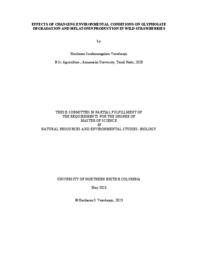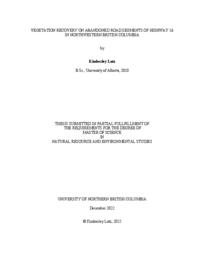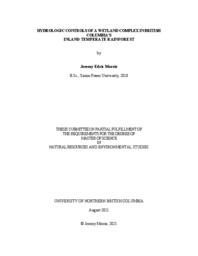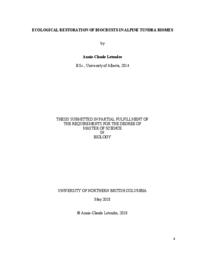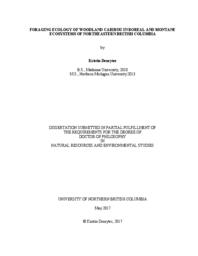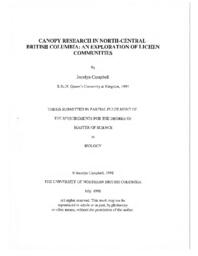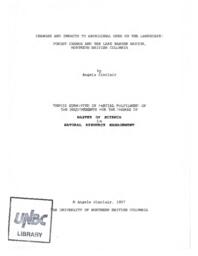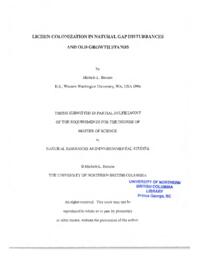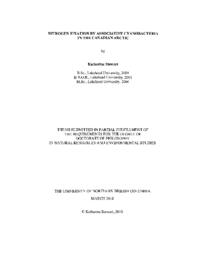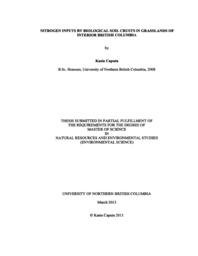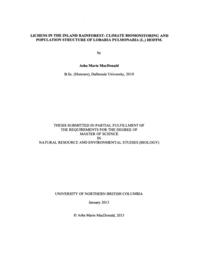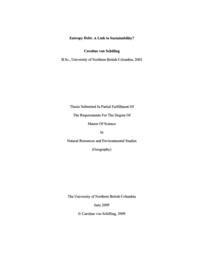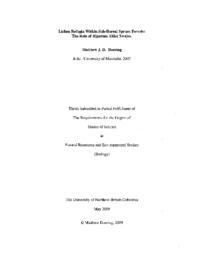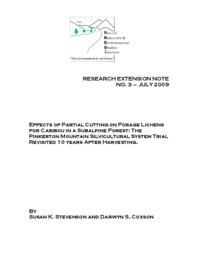Coxson, Darwyn S.
Person Preferred Name
Darwyn S. Coxson
Related Works
Content type
Digital Document
Description / Synopsis
Glyphosate is a broad-spectrum herbicide commonly used in Canadian forests to control competitive vegetation. The non target plant species are exposed to a sublethal dose of glyphosate-based herbicides (GBH) due to aerial applications that cause deformities along with other potentially unknown effects. The efficiency and degradation of glyphosate to its metabolic by-products, including amino-methyl phosphonic acid (AMPA), are based on environmental conditions and the genetic capabilities of the plant or exposed organism. Glyphosate enters the plant through foliage and blocks the production of aromatic amino acids such as tryptophan by inhibiting the plant enzyme 5-enolpyruvylshikimate-3-phosphate synthase (EPSPS). Interestingly, the amino acid tryptophan acts as the precursor of the plant stress response hormone called melatonin. Whenever a plant is exposed to biotic or abiotic stress, the level of melatonin increases to protect the plant. The production of melatonin also tends to change depending on the environmental conditions. Glyphosate-based herbicides may act as a chemical stress, and the plants may respond to it by increasing melatonin concentration. The objectives of this research were: 1)To find out how environment, in this case, measured by the effects of the combination of temperature and photoperiod, affect plant stress responses to GBH application, and to determine which combination of temperature and lightsupported the faster degradation of glyphosate to its secondary metabolite AMPA; 2) To determine the effects of changing environmental conditions and GBH application on a plant’s melatonin production. I used wild strawberries (Fragaria virginiana) as my experimental species as they are a common understory species grown in the forest areas of British Columbia, Canada, where GBH is sprayed, and are also of importance as food to humans and wildlife. I used 1080 g/m2 of GBH treatments in my experiment to replicate the sublethal dose received by the non-target plants in industrial operations. Several plant stress responses were observed during the measurement period in three different trials. Trial 1 had different temperatures with constant photoperiod, trial 2 had different photoperiods with constant temperature, and trial 3 combined variation in temperature and photoperiod. At the end of experiment, I found that GBH were highly effective at 20°C with 18 hours of photoperiod as it affected several plant morphological features. The degradation of GBH were maximum at 20°C with 24 hours of photoperiod as suggested by the degradation ratio of glyphosate and AMPA. The new leaves produced by the plants after GBH application were more sensitive to glyphosate as leaf area and photosynthetic capacity by the new leaves were severely affected compared to the previously emerged leaves. Melatonin levels were altered by temperature, week of sample collection and slightly by photoperiod. The production was not affected by GBH application. These results suggest that wild strawberries grown in forest areas with warmer temperatures are most highly affected by glyphosate applications and when warm temperatures are accompanied by longer duration of sunlight, faster degradation of glyphosate is facilitated in tissues.
Origin Information
Content type
Digital Document
Description / Synopsis
Vegetation recovery on abandoned road segments of Highway 16 in northwestern British Columbia were examined across a climate gradient. The time since road abandonment ranged from 16 to 57 years on sites sampled. Plant cover on asphalt roads was compared with that found on gravel road shoulders using paired t-tests. Plant cover by growth form was further evaluated in response to climate and other environmental predictor variables using multiple regression ‘best fit’ models. Plant community ordination analysis using nonmetric multidimensional scaling was conducted to describe patterns across study sites in species space along environmental gradients. Key drivers of current plant community composition include time since road abandonment, road substrate type, and several different annual climate variables. The best predictor of vascular plant cover and total plant cover was time since road abandonment, but plant community composition was strongly driven by the coastto-interior climate gradient. Non-vascular cover was more abundant on asphalt roads compared to gravel substrates. Woody plant cover was greatest on gravel shoulders compared to gravel or asphalt road centers. Exotic plant cover was negatively correlated with mean annual relative humidity. Plant diversity and species richness were not driven by the climate gradient but instead reflected more site-specific environmental variables. Primary succession on abandoned roads in this study area may be constrained by continued anthropogenic disturbance post-abandonment.
Origin Information
Content type
Digital Document
Description / Synopsis
Ancient Forest/Chun T’Oh Whudujut Provincial Park (AFP) is part of British Columbia’s (BC) inland temperate rainforest that receives high total annual precipitation amounts (>1000 mm) from orographic enhancement. AFP hosts a ~4 km2 complex of valley bottom wetlands which is supported by this precipitation, a good portion of which falls as snow. This study examines the hydrology of the wetland complex to determine the primary water sources and their influence on flow paths and recharge. Water levels and meteorological conditions were monitored for 2019 and 2020, and water samples were collected for isotopic data during the 2020 snow free period. Kriging of water level data revealed a northeastward nearly flat hydraulic gradient that shifted orientation during wet and dry periods through the summertime. Rainfall amounts were above average at 700.2 mm and 676.4 mm while snow water equivalent varied at 762.8 mm (below average) and 1082.8 mm (above average) for 2019 and 2020, respectively. The reduced snowpack of 2019 yielded lower water levels through the summertime when compared to those of 2020. End Member Mixing Analysis (EMMA) of stable water isotope data indicates that rainfall is not a significant enough recharge source to alter the wetland groundwater composition, while snowmelt is likely the dominant source of input for the groundwater. Cross correlation between rainfall and water level data indicates however that water levels do respond to rainfall events with lag times ranging from 13 – 30 hrs. This observation leads to the conclusion that rainfall serves to flush stored snowmelt generated water from the soils into the wetland complex, though not in a significant enough volume to replace snowmelt as the dominant soil water source. Since previous research has concluded that by 2050 as much as 50 % of the current snow contribution to total annual precipitation will be replaced by rainfall, this study indicates that this shift in precipitation regime may result in lower water levels in the wetland complex. Numerical modelling of the relationship between wetland water levels and precipitation phases and amounts would improve the understanding of the climate resiliency of valley bottom wetlands in the Robson Valley.
Origin Information
Content type
Digital Document
Description / Synopsis
Plant communities and soils of grasslands on an elevation gradient and the forest-grassland mosaic in the Cariboo-Chilcotin of British Columbia were examined. Vegetation change along an elevation-climate gradient was analysed, including plant cover, litter cover, species composition, and species richness. Grassland plant communities were compared with associated climate variables and biogeoclimatic classifications. Based on results, an updated classification of grassland ecosystems is proposed with suggestions for management and research. Plant community and soil moisture characteristics of adjacent forests and grasslands were compared. Ten-year-old slash and burn treatments of young forests, and areas of forest encroachment on grasslands were studied to detect potential change between forest and grassland states. Results did not suggest change in ecosystem state between grasslands and forests, with persistent ecosystem legacies a potential source of long-term resilience. Land-use legacies manifested as encroachment of forests on areas of historical grasslands and high cover values of exotic species.
Origin Information
Content type
Digital Document
Origin Information
Content type
Digital Document
Origin Information
Content type
Digital Document
Origin Information
Content type
Digital Document
Origin Information
Content type
Digital Document
Origin Information
Content type
Digital Document
Origin Information
Content type
Digital Document
Origin Information
Content type
Digital Document
Origin Information
Content type
Digital Document
Origin Information
Content type
Digital Document
Origin Information
Content type
Digital Document
Origin Information
Content type
Digital Document
Origin Information
Content type
Digital Document
Description / Synopsis
"Partial cutting systems have often been proposed as a means of maintaining canopy lichen abundance and diversity in managed forests. However, most assessments of the effectiveness of specific harvest practices in maintain canopy lichens are based on immediate post-harvest measurements. Fewer assessments extend beyond the immediate 2-3 year post-harvest period. We anticipate that changes in lichen community composition will occur for many decades after harvesting, as lichens respond over time to changes in canopy microclimate and substrate availability. We can now report on the response of canopy lichen communities 10 years after partial cutting at Pinkerton Mountain, in B.C.’s central interior, where 30% of the timber volume had been removed in a side-by-side comparison of two partial-cut harvesting treatments: one in which trees were removed in patches, as part of a group selection silvicultural system, and one in which trees were removed singly from throughout the harvest unit, as part of a single tree selection silvicultural system. Our measurements show a shift in canopy lichen genus composition, with the proportion of Bryoria – the preferred winter forage of the red-listed mountain caribou – gradually increasing in relation to Alectoria. However, it will still be many decades before overall forage lichen loading in the partial cut harvest stands approaches that of uncut adjacent old-growth forests. Thus, although partial cut harvesting is an effective strategy for maintaining winter forage for mountain caribou, it cannot substitute for maintaining core habitat in a natural state."
Origin Information

